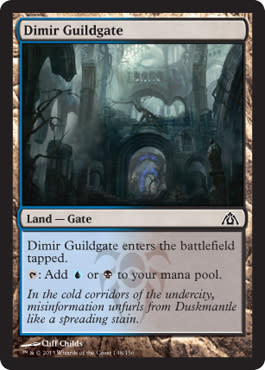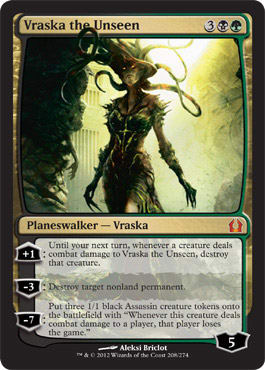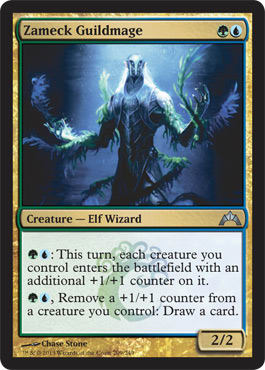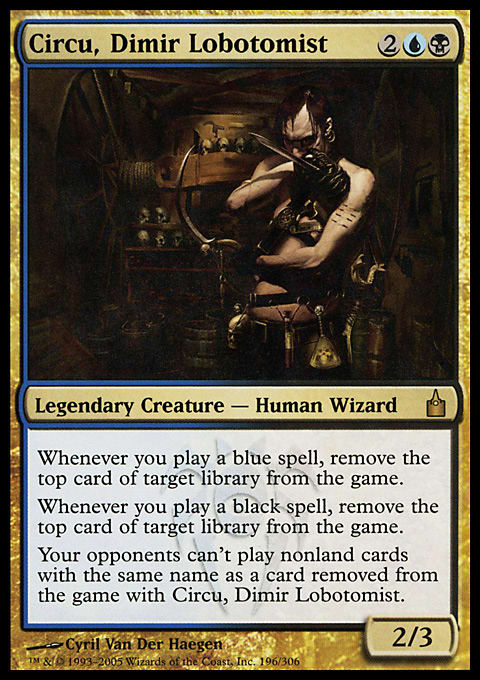When I heard that they were going to be making a new Ravnica block, I knew I would eventually be putting together a Full Ravnica Cube, much like my Full Mirrodin Cube I’ve talked about a few times in the past. Now that I’ve drafted a bunch of times with Return to Ravnica and Gatecrash, my brain is churning with a ton of ideas of how the old block and the new one could interact in a Limited environment. I’ve decided that I’m not going to wait until Dragon’s Maze to start hammering out a list, as it should be pretty easy to just make an update when the set does come out.
What really excites me about this Cube is that I have a new way to do the Draft that specifically takes advantage of the guild system. Normally with a Cube, you just have a big stack of cards that you shuffle together and make packs out of. While hanging out with one of my buddies, we came up with the following system: Each pack has specific predetermined guilds in it. Say for example you wanted to use the original Ravnica-block model. That means pack one will have Dimir, Boros, Selesnya, and Golgari. Pack two has Izzet, Orzhov, and Gruul. Pack three has Simic, Azorius, and Rakdos. Or maybe you want to go with the new block and have all ten guilds pack one, the Gatecrash guilds in pack two, and the Return to Ravnica guilds in pack three. You could even get creative and come up with your own pack structure or just randomly determine which guilds go in which packs.
This adds a layer of strategy that other Cube formats lacks, and I think it is going to be insanely fun when I actually sit down and draft with my friends. I’m getting goose bumps just thinking about it. Of course, drafting in this way requires considerably more work to set up beforehand and clean up afterward. I think the extra work more than makes up for it, but there’s certainly nothing wrong with shuffling up the whole Cube and drafting it normally. I’m probably going to have premade packs ready to go so that I don’t put the burden on my players to figure out my Byzantine system.
This week, I’m going to address the logistics of putting this together. This is going to be the toughest Cube project I’ve undertaken in terms of design, so I’m going to proceed carefully. The first step is figuring out which cards belong to which guild. I thought about a few different ways of doing this, but I think the following rule is best:
I’m imposing this rule because it’s nice and simple. It’s really easy to be drawn into arguments about non-aligned cards being lumped in with a particular guild. Having a clear-cut rule here makes everything else down the line a lot less of a pain in the ass. It especially makes cleanup at the end of the Draft a lot easier since you don’t have to remember which card goes where. The only exceptions are the multicolored planeswalkers (Vraska the Unseen and Domri Rade . . . so far). They technically don’t have a watermark on them, but it makes sense to group them with Golgari and Gruul respectively.
The next step is figuring out how many cards I want in the Cube and what the proportions of guildless vs. guild cards should be. Using my trusty Microsoft Excel program, I have all of the existing card sets divided up into each guild plus an eleventh “guildless” guild. Overall, the percentage of guildless cards is about 45% (so guild cards make up about 55%). I’m going to use the same proportions for my Cube: 45% is guildless, and the remaining 55% is split up evenly among the ten guilds.
I’m going to shoot for a 460-card Cube. That’s been roughly the size of my previous Cubes, and it’s been working out well. That means I’m looking at 207 guildless cards and 25 or 26 cards per guild. If you’re planning on building your own with a different number of cards, you’ll have to adjust your numbers accordingly.
I’ve thought about whether to figure out the guild cards first and then the guildless cards or the other way around. I think because the guildless cards allow for a lot more flexibility and I can fill holes where I see fit with them, the best approach is figuring out the cards for each guild first and then addressing any color balance or curve issues with the guildless cards. I have a pretty good idea of which guildless cards are on the short list, whether because they’re unilaterally sweet or because they have particularly good interactions with one or more Guilds. We’ll get to those in a future article.
These are the general guidelines I’m going to follow for each guild:
- Include the guild cycles: the Guildmages, the Signets, the guild leaders, the guild champions, and so on.
- Include the “important” commons and uncommons that were high picks in Draft.
- Pay attention to how mechanics interact between the old Block and the current one.
- Don’t forget curve fillers and sideboard cards.
Now let’s see this in action with my favorite guild: Dimir. In triple-Ravnica, Dimir decks were highly focused on a mill strategy, but as the format grew with additional sets, that became less viable. The guild still was great for card advantage and controlling your opponent’s threats. In Gatecrash, the mill theme still exists, but it is nowhere near as successfully as it once was. Good Dimir decks (they exist; I assure you) play more of a tempo game with evasive creatures backed up by counterspells, bounce, and removal.
I’d like both types of decks to be viable, and there should be plenty of cards in a third color that can support Dimir, whether you’re looking for additional defensive creatures and removal or more cheap, evasive threats. Esper control is just as good here as in most Cube formats. A G/U/B deck that mills itself looking for dredge cards and creatures with scavenge can be viable as well. Let’s work out cards that are making the short list:
Cycle cards – Szadek, Lord of Secrets, Circu, Dimir Lobotomist, Dimir Signet, Dimir Aqueduct, Duskmantle, House of Shadow, Watery Grave, Dimir Guildmage, Dimir Charm, Dimir Guildgate, Dimir Keyrune, Lazav, Dimir Mastermind, Duskmantle Guildmage
High-pick Draft commons and uncommons – Brainspoil, Moroii, Psychic Drain, Ribbons of Night, Bane Alley Broker, Call of the Nightwing
Sweet rares – Glimpse the Unthinkable, Consuming Aberration, Mind Grind, Soul Ransom, Stolen Identity
That leaves room for two or three more role-players. My creature count is a bit low, so I’ll add two creatures that I happen to like: Nightveil Specter and Dinrova Horror. If you’re following along, you don’t have to copy exactly, and I certainly understand if you’re constrained on card availability. I can guarantee that my actual list will be quite a few cards off my ideal list for that reason. This is more about the process than the actual result.
All right, so this gives us our Dimir list:
Next week, I’ll be going through a few more guilds. Feel free to leave me a comment if you want me to feature your favorite guild. Happy cubing, and I’ll see you next time.
Take care,
Nassim Ketita
arcticninja on Magic Online
http://www.youtube.com/nketita


























